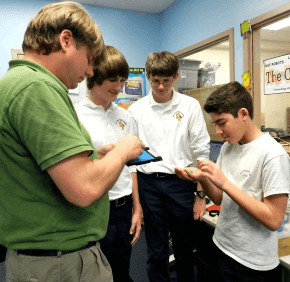By Mary K. Tilghman
Special to the Review
Copybooks, pencils and the occasional spelling bee don’t cut it in today’s classroom.
Instead, today’s students track their cardiovascular activity online, collaborate on schoolwork via Google Documents and use 3-D printers to build a village.
The result? Students are more engaged than ever, say teachers at three parish schools in the Archdiocese of Baltimore.
3-D learning at St. Philip Neri
A basement classroom at St. Philip Neri School in Linthicum was abuzz. Two 3-D printers were building pieces for a board game designed by three eighth-graders. Another group was exploring ancient worlds in an educational version of Minecraft. Nearby a third group programmed Lego robots to play soccer.
All are members of the school’s Technology Club, which attracts about 24 students from fourth to eighth grade every Wednesday after school. Music teacher Philip Lathroum, who with teacher Cindy Jones advises the group, zipped between groups.
Heads bent to their work, these students are having fun as they learn geometry and history, electronics and art. They become familiar with computer-assisted design (CAD), area and perimeter, and the metric system.
Every year, third-grade social studies classes turn their study of community into a 3-D project, building a village with roads, water towers, houses and office buildings. Teacher Kasey Burch devised the project three years ago. The project begins in social studies, and moves to the technology lab and art class as individual buildings are created, and finally back to social studies where students build the villages.
“They all work together,” Burch said, adding “They get more out of it.”
And at the end of the year, they get to take home their building.
“It gives them something tangible to hold onto,” Burch said.
High tech lab at Cathedral School
Tools in the new lab – light meters, microscopes, tuning forks and even a spectrophotometer – at the School of the Cathedral of Mary Our Queen in Homeland have students more engaged in their lessons, say their teachers.
“We’re lucky enough to have tools that scientists use,” said Jill Emerson, who teaches fourth grade math and science.
“It allows them to make more real-world connections,” Emerson said.
After studying the boiling and freezing points of water – and the effects of salt – students realized how ice melt works on an icy sidewalk.
Chrome Book laptops in middle school and iPads for younger grades give students access to websites and educational apps. Middle school students use their laptops to follow along during a PowerPoint presentation, and use a math practice program or write a paper. Student work is uploaded to Google Docs, where teachers can read it and students can work on it outside of the classroom, explained Lisa Metzbower, who teaches seventh- and eighth-grade science.
“It gives students a chance to collaborate with each other,” she said.
Schoolchildren are already comfortable with technology. For their spring science fair projects, fourth- and fifth-graders created websites for their charts and findings.
“That’s the future, being able to collaborate and present their data,” Emerson said.
Tech-savvy PE at St. Louis
The new John Evans Memorial Gymnasium at St. Louis Parish and School in Clarksville has two gleaming basketball courts, seating for assemblies and school plays.
Its school also has a tech-savvy gym teacher who uses videos, pedometers and Wii games with his students.
“I’ve always used technology,” said Norm Belden, a 39-year teaching and coaching veteran now in his second year at his parish school.

Norm Belden
Pedometers keep kids moving even when they are waiting for class to begin. Belden will turn on music so they can dance or jog in place.
“They’re even moving when they’re not in a position to move,” he said.
Belden has introduced a scientifically-based curriculum, called SPARK PE, complete with videos, to teach new games, new skills, whatever will keep kids active.
He posts recess games and family activities on his new website and organizes parish Family Fitness Fun Nights.
Some students are active in Howard County’s many sports programs, others are more sedentary. He hopes his program will teach all of them how to maintain an active lifestyle.
“We meet the students where they are,” Belden said. “I teach them lifetime activities – things you can do all your life.”
Also see:


